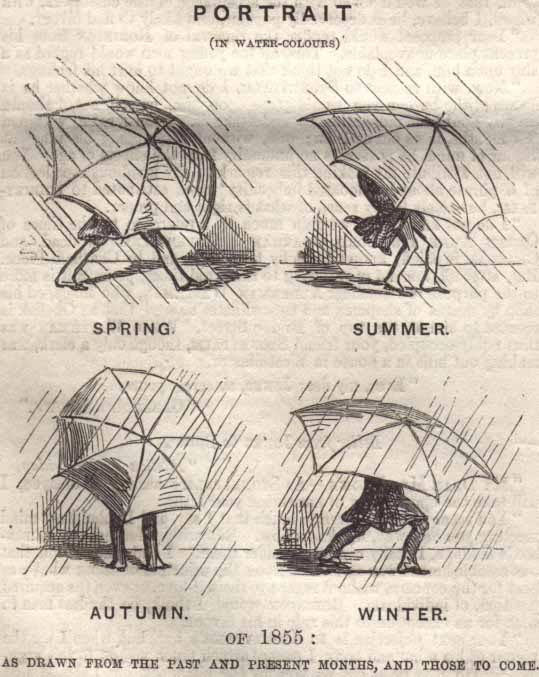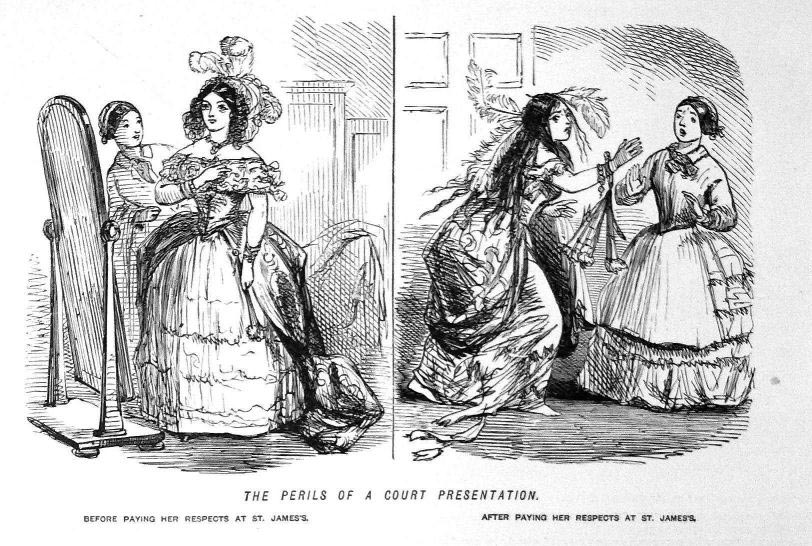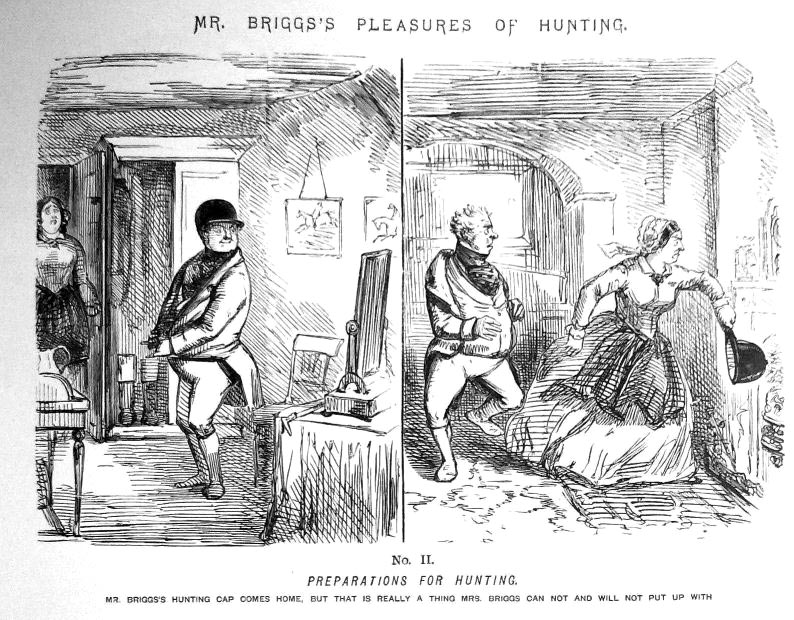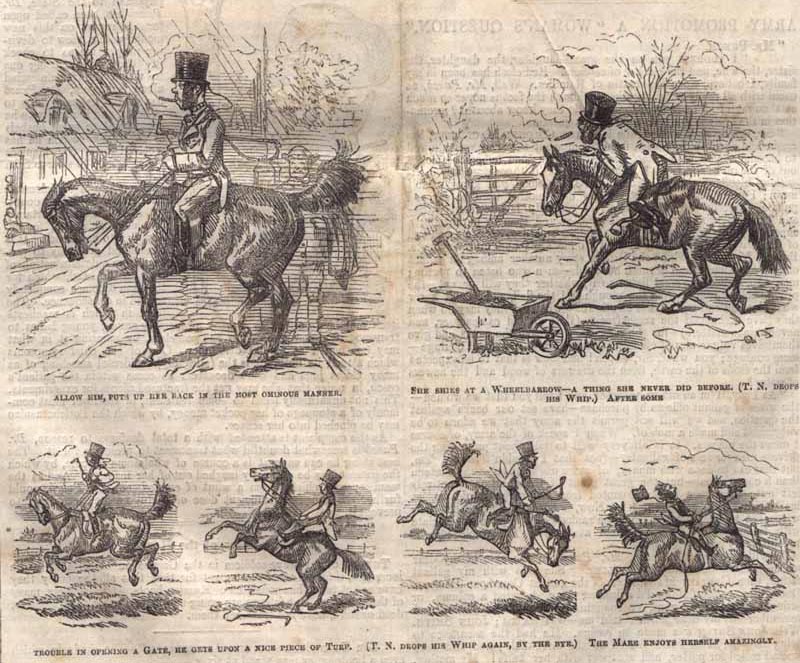'The Great Chartist Demonstration' (1848).
John Leech was a mid-19th century British caricaturist, illustrator and cartoonist. He is famous as the first illustrator of Charles Dickens' classic novel 'A Christmas Carol' (1843) and, together with Robert Seymour and George Cruikshank, the most famous of all Dickensian book illustrators. Leech was also active as a cartoonist for Punch. Many of his cartoons were concerned with the plight of the poor, though others were more straightforward humorous drawings. Some made occasional use of speech balloons and sequential drawings. One of them, 'Mr. Briggs' (1849), can be considered a prototypical comic series. Together with Thomas Rowlandson's 'Dr. Syntax' (1820) it's one of the earliest examples of a recurring comic character.
Early life
John Leech was born in 1817 in London as the son of a landlord of Irish descent. He showed drawing talent at an early age. Veteran artist John Flaxman was among the first to pay him a compliment for it. Leech studied at Charterhouse School, where future novelist William Makepeace Thackeray (famous for 'Vanity Fair' and 'Barry Lyndon') was one of his classmates. The young artist continued his medicine studies at St. Bartholomew's Hospital, specializing in several anatomically correct illustrations. Still, his heart was more devoted to drawing and so he left his studies to become a cartoonist. His biggest graphic influences were James Gillray and George Cruikshank, the latter with whom he created a few etchings. Cruikshank also motivated him to publish his work in as many papers and magazines as possible. As a result, Leech's cartoons first appeared in print when he was just 18 years old. They were published in the magazine Bentley's Miscellany.
'Portraits of the Children of Mobility' (1841).
Socially conscious cartoons
Leech made numerous etchings, lithographs and woodcuts based on sporting scenes and everyday life in London streets. His first publication was the pamphlet 'Etchings and Sketchings, By A Pen, Esq.' (1835). Other (humorous) pamphlets like 'Comic Latin Grammar' (1840), 'The Fiddle-Faddle Fashion Book' and 'Portraits of the Children of Mobility' (1841) followed. In 1841 he joined Punch, where he would remain a regular contributor until his death. Leech also provided artwork for Punch's annual almanacks and pocket-books. Thackeray once said that the popularity of Punch owed more to Leech than perhaps any other man. The artist could be read in Bell's Life in London (1830s), London Magazine (1840), Shilling Magazine (1845), the Illustrated London News (1856) and Once A Week (1859-1862).
One of his best known cartoons is 'Substance and Shadow' (1843). It shows a group of poor people gazing at paintings in a lavish art gallery. The contrast between the triviality of "high art" and their far more serious problems remains powerful until this day. The same year Leech created another iconic socially conscious cartoon: 'Capital and Labour' (1843). The work criticizes the living conditions of the common people, inspired by a parliamentary report on child labor in the United Kingdom. In the cartoon three separate images are depicted within one drawing. On the top we see rich upper class people enjoying their luxury, while below them poor workers slave and starve away in a coal mine. The central figure is a hunchbacked man with crooked legs, barely able to keep in balance on his stick. 'Capital and Labour' has become one of the defining images of the Industrial Revolution. The cartoon has been reprinted in countless history books. The work is also interesting as a prototypical comic. The comparison between the rich and poor life can be interpreted as happening simultaneously, but the reader can also read the images as a continuation in time.
'A Christmas Carol' (1843). Ebenezer Scrooge meets the ghost of his former partner, Jacob Marley.
A Christmas Carol
Leech was very concerned about the darker side of the Industrial Revolution. While the factory owners became rich off their properties, many of their employees worked long and exhaustive hours for a measly payment. Those without a job had to live like beggars or criminals to survive. Leech's cartoons caught the attention of another socially conscious celebrity: Charles Dickens. Leech had tried to get in touch with the popular novelist before, when Dickens looked for a new illustrator of his popular series 'The Pickwick Papers' after the original illustrator, Robert Seymour, had committed suicide. Back then Dickens had shown no interest. But now he asked Leech to illustrate his next story: 'A Christmas Carol' (1843). The tale of the greedy miser Ebenezer Scrooge and his change of heart on Christmas night was perfect material for the artist. It offered a strong message of helping the needy. Leech visualized the dark, foggy streets of London and the poverty of the disadvantaged. Much of the atmosphere, characters and moving series of events were deeply etched in the public consciousness through his garish-looking drawings. He created the definitive visual designs of Scrooge, his ghostly partner Jacob Marley, poor employee Bob Cratchit and his crippled son Tiny Tim, the jolly Fezziwig, the guilt-inducing children Ignorance and Want and the Ghosts of Christmas Past, Present and Future.
Many illustrators and comic artists have given their own interpretations of this timeless classic, including Sol Eytinge Jr., Fred Barnard, Arthur Rackham, E.A. Abbey, Harry Furniss, Henry Matthew Brock, Ronald Searle, Anton Pieck, Alfred J. Buescher, Henry Kiefer, Peter Fluck and Roger Law (as a photo book, with caricatural wax models), Quentin Blake, Michael Cole, Mario Capaldi, Bill Fraccio, Dick Matena, Gabriella Baracsi, Gerald Kelley and José-Luis Munuera. But they all borrowed imagery from Leech's original illustrations. Countless theatrical, film and television adaptations did the same. Therefore Leech, just as much as Dickens, can be attributed with popularizing the Christmas holidays and turning 'A Christmas Carol' into the second most famous Christmas story after the birth of Jesus. Carl Barks based the name and personality of his Uncle Scrooge character in 'Donald Duck' on Ebenezer Scrooge. Leech furthermore illustrated Gilbert Abbott à Beckett's 'Comic History of England' (1847-1848) and a 'Comic History of Rome' (1852).
'Sailors on Shore Carousing' (1850).
Prototypical comics
John Leech's illustration work was also an important contribution to the history of comics. Some of his cartoons make use of speech balloons. In 'Making the Best Of It' (1845) a man goes swimming in the sea while clearly shivering, but still tries to convince his friend that "it's very warm." Speech balloons also appear in one-panel cartoons like 'A Pleasing Delusion' (1846), 'Gammon (1847), 'How To Make Culprits Comfortable' (1849), 'The Betting Fever' (1851), 'Probable Result of the Cochin China Fowl Mania' (1853), 'Stunning Politeness' (1856), 'Domestic Event at the Zoological Gardens III' (1850), 'Bitter Sarcasm' (1850), 'Topsy Turveydom' (1850), 'Sailors on Shore Carousing' (1850), 'Ladies of Creation - No. III - The Dining Room' (1851), 'Ladies of Creation - Bloomerism No. II'i (1851) and 'Life in An American Hotel' (1856).
'Weather, As Drawn From The Past and Present Months, And Those To Come' (1856).
Closer to modern-day comics are various cartoons which use two sequences. In 'Artful Excuse' (1847) a servant maid asks her mistress if she is permitted "to go out for half-an-hour and buy a bit of a ribbin?", while the next image shows the actual reason why she wants to go outside: a man in uniform is waiting for her. 'Here and There, or, Emigration: A Remedy' (1848) depicts the life of a poor and miserable family in the United Kingdom in the left image ("Here"), while the right image ("There") shows a rich and happy family sharing a huge meal in the United States. 'A Cheap Day's Hunting' (1849) is a two-parter cartoon ridiculing a horse rider. In the first panel we see him full of high spirits and ready to go out riding, while in the second panel he returns bruised and battered. A similar "before and after" story is told in 'The Great Chartist Demonstration' (1848). Demonstrators rally against the system in one panel, but quickly run away from the mounted police in the next. Equally cynical is 'More Free Than Welcome' (1849), where a maid tells her mistress that she let a man in who claims to be "a friend of the master". In the next image we see this "friend" stealing all the furniture and sneaking back out.
'The Perils of A Court Presentation' (1851).
'The Perils of A Court Presentation' (1851) shows a woman preparing to go to a court presentation. This was an opportunity for young women to present themselves to bachelors. In the next panel we find out that the men presumably fought to get her first. An extra joke is that she went to St. James's, a street known for its many gentlemen's clubs. Women are ridiculed again in 'Ladies of Creation - Bloomerism No. II' (1851),where the sort of leg that would actually look good covered by the latest fashion is announced. In the next panel they turn out to be legs covered completely underneath bloomer dresses. Another two-panel cartoon, 'A Very Young Mariner/ A Mariner' (1852), shows the age and attitude difference between a young boy interested in mariner life and what he presumably becomes once he turns adult. A similar cartoon is 'The Garret and the Conservatory' (1852), where Leech depicts the different lives led by a garret and a conservatory. Particularly interesting is 'Battle of the Pianos' (1855), which shows two families in opposite rooms trying to drown out their neighbors with loud piano music. The cartoon uses two panels as well as speech balloons. Also worth mentioning is the one-panel cartoon 'Hunting Memorandum' (1853) where a man fell from his horse. His pain and dizziness are visualized through a series of scribbles, stars, curly drawings and vague images, which predate similar symbols used in comic strips. A timeless cartoon, 'Weather, As Drawn From The Past and Present Months, And Those To Come' (1856), proves that even back in the day English weather was associated with constant rain. We see a man hiding underneath his umbrella during heaving rainfall in all four seasons. Leech uses four sequential images to tell this gag.
'Mr. Briggs's Pleasures of Hunting'.
Mr. Briggs and Tom Noddy
Leech's most significant contribution to comic history is his one-panel cartoon 'The Pleasures of Housekeeping' (1849), which introduced a comedic character named Mr. Briggs. From 1850 on this bumbling man appeared in a series of text comics which occasionally feature speech balloons. They are different from his other cartoons since they actually follow a storyline. In four episodes Briggs tries out hunting, shooting, racing and fishing, all with disastrous results. Briggs can be considered one of the earliest recurring comic characters, after Thomas Rowlandson's 'Mr. Syntax' (1820). The series appeared nearly two decades before Émilie de Tessier (Marie Duval) and Charles H. Ross created 'Ally Sloper' (1867). It even acquired some celebrity fans. John Everett Millais painted a portrait of a child reading the comic book 'Mr. Briggs' Sporting Tour'. This may very well be the first comic book to be part of a painting. Novelist Georges du Maurier also loved Mr. Briggs and praised it as "Leech's masterpiece" with the following words: "(…) the example above all others of the most humorous and good-natured satire that was ever penned or penciled."
'Mr. Tom Noddy's First Day With The Hounds After the Long Frost' (1855).
Du Maurier enjoyed another comic character by Leech too: Tom Noddy. Noddy debuted in the text comic 'Mr. Tom Noddy's First Day With The Hounds After the Long Frost' (1855). The story features a gentleman in a high hat who goes out riding in the woods. Noddy is just as unlucky as Briggs, which leads to a lot of mayhem and slapstick. Apart from Thackeray, Millais and Du Maurier, British Prime Minister William Gladstone was also an admirer of Leech. And novelist John Ruskin once praised his work as "admittedly the finest definition and natural history of the classes of our society, the kindest and subtlest analysis of its foibles, the tenderest flattery of its pretty and well-bred ways."
Legacy and influence
John Leech passed away in 1864. He was a direct influence on John Tenniel, whose drawings he considered to be far superior than his. Georges du Maurier and Charles Keene. When Michael Cole illustrated Dickens' 'A Christmas Carol' in 1985, some images were directly lifted from Leech's classic illustrations of Dickens' tale, but drawn in a more realistic style. Cole also paid homage to Leech's 'Capital and Labour' cartoon in the scene where Scrooge and the Ghost of Christmas Future walk through the slums of London.












